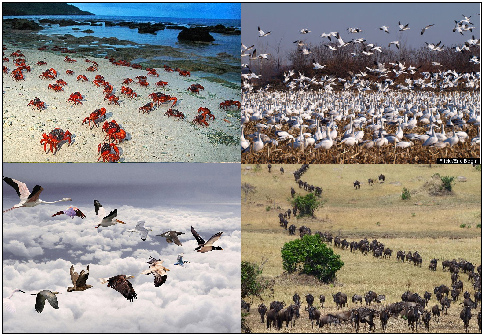Unsuspected benefit of getting away
A study shows that rejuvenation is an important factor to induce taking a break, says S.Ananthanarayanan.

The migratory behavior of birds, fish, insects and even animals is fascinating to observe, both as a mystery of why it has evolved as well as the incredible endurance that many species exhibit during the movement, often over thousands of kilometers.
Mathematician Allison K Shaw of the University of Minnesota and naturalist Sandra A Binning of the University of Neuchâtel, Switzerland, describe in their paper in the journal, The American Naturalist, a mathematical analysis of the costs and a benefits of
animal migration, as against staying put. Apart from climate and habitat, which are the reasons to migrate that have been considered so far, Shaw and Binning consider the benefit escaping attack by parasites as being another major gain. Migration, however,
has its costs of risk and hardship, and they examine the conditions required for migration to still be viable as a method of escape from parasites. The study shows that apart from escape, including a degree of recovery from the effect of parasites that have
already had access brings the model closer to reality and allows partial migration to evolve.
Migratory movement, in this sense, is not just dispersal or spread of animals when their numbers increase, but a seasonal movement of a group of animals to a new habitat at a distance. Instances are of birds in the northern hemisphere that fly to the south
for the winter, antelopes and wildebeest in Africa that move 800 km seasonally for pasture or for calving, fish that move to spawning waters, often changing from salt water to fresh, or vice versa, sea birds that come ashore to breed, and so on.
Avoiding harsh weather, seeking food, safety during the breeding season, to help optimize the chances of survival in the face of changing environment, are good reasons for migration. An additional reason, although not equally well studied, Shaw and Binning
say in the paper, could be migration as a strategy to lower the risk and consequences of attack by infection or parasites. . Parasites are often adapted to existing conditions of salinity, humidity etc. and movement of the host to a different clime may make
it difficult for the parasites to survive. However, as all factors that promote migration are usually active at the same time, it is difficult, in practice, to isolate the separate reasons why migratory behavior has evolved. Theoretical studies, however, are
useful in considering how the influence of different factors may rise or fall in varying conditions, leading to insights into how migration may have evolved, the authors say.
Two mechanisms by which migration may deal with attack by parasites have been suggested, the paper explains. One is escape – by getting physically away from the environment that harbors the parasite. The other is migratory culling, where the act of migration
places stress on individuals infected by pathogens or parasites, so that many of the infected hosts do not survive. The current authors suggest a third mechanism, of recovery from parasite attack during migration. “Many migratory species move between different
habitat types or across strong environmental gradients (e.g., temperature, humidity, salinity, altitude, dissolved oxygen). Parasites are often picked up and lost at different rates in these habitats,” the authors say. Washing fish in water of different salinity
to get rid of parasites or skin infections is commonplace, and there are studies of the behaviour of some animals to seek warm climate or of birds to sun themselves to be free of parasites in their feathers. The same effect, of infection control, however,
has not been considered so far as an explicit reason for migration, the paper says.
Mathematical model
The paper creates a model of a population of individuals that live in a parasite infested environment, from which (some) a section of the individuals migrates for a period, while the remainder does not. While migration is arduous and takes its toll, the benefit
is that some of the infected ones that migrate would get rid of the parasites, while infected individuals that do not migrate would continue to be affected, and hence pay an infection-cost. And then, during the period of migration, some of the healthy ones
that (who) stayed back would get infected. Some of those that stayed behind would also die in the normal course and a so would a somewhat higher percentage of those that migrated, because of the stress of migration.
And finally, the migrants would return to the home habitat, which is the breeding ground. As the formula that has been developed gives a measure of how many healthy and infected individuals join in the breeding season, the model
is able to give the number of offspring born, and the newborns are taken to be without infection. The model also provides for a fecundity-cost, of the effect of infection on the ability of individuals to reproduce. The model hence works out the numbers of
healthy and infected individuals at the beginning of the second year, based on the numbers at the start of the first year. This, of course, is according to the assumptions of the proportion of the population that gets infected in a given time, the proportion
that migrates, as well as the rates taken for normal attrition, the infection cost, migration cost and the fecundity rates.

Given this picture of change over the year, the proportion that migrates, as assumed in the model, is moved up or down, till the numbers at the start of the second year come out the same as at the start of the first, which is to
say that there is equilibrium. This then provides a measure of how evolutionary forces should result in the proportion that actually migrates, for sustainability - the evolutionarily stable strategy.
The factors that were considered to affect the choices are (i) likelihood of infection in the home environment and of recovery during migration. (ii) likelihood of survival even when not infected, (iii) survivals costs, both of
infection and of migration and (iv) the effect of infection on reproductive ability. In the case where there are very high chances of infection as well as of recovery, the best strategy simply works out to comparison of the cost of migration and that of staying
put, and is a simple one or the other strategy. But in real life, Shaw and Binning analyse, even if there were a low chance of infection and the cost of migration were high, never to migrate would mean that an individual would have no way of recovery, once
she was infected, as sometime she must. The best strategy to evolve would hence be a mixed strategy, where a part of the population migrates and a part stays home, so that the chances of survival and hence the annual reproductive potential are optimised. This
is relevant, of course, the authors add, mostly when the lifetime of the organism is more than a few seasons, and mixed strategies are generally favoured when the chances of recovery are high and infection rate is low. With higher infection rates, migration
is generally the better choice. At the same time, they note, there are also counter-intuitive results when infection affects both survival as well as reproductive capacity. Migration may then become unlikely, as the organism may not live long enough for occasional
migration to help.
Researchers are increasingly recognising that parasite pressure can be a driver of large scale movement of animals, the authors say. While there are instances known of specific life cycle history in response to parasites, parasite
evasion has not been examined as the reason for the evolution of seasonal migration behaviour. On the other hand, researchers have paid more attention to the negatives of migration, like being susceptible to unknown pathogens, crowding at stopover points or
the weakened condition on arrival at the destination, the authors say. However, as migration is a fact, these negatives must be getting offset by the benefits, they say.

The scientists
Although there is little experimental data to support migratory recovery, there are instances of migrants benefiting by loss of parasites, and migratory recovery is a valid mechanism that explains evolution of partial migration, the authors say. The present
model that has been developed based on a long distance migration, but it could be modified to suit other conditions, they say. They invite other researchers to take into account the loss of parasites as a factor while studying animal movements and also to
improve the current model by refining the assumptions made.
[the writer can be contacted at response@simplescience.in]